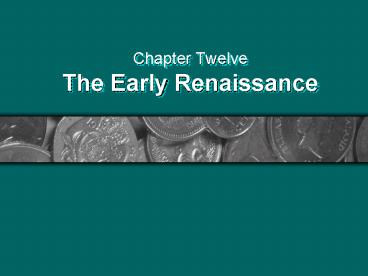Chapter Twelve The Early Renaissance - PowerPoint PPT Presentation
1 / 48
Title: Chapter Twelve The Early Renaissance
1
Chapter TwelveThe Early Renaissance
2
Toward the Renaissance
- Renewed interest in Classical texts
- New artistic realism
- Attention to the world of nature
- St. Francis of Assisi
- New growth in economics/trade
- Florentine banking and commerce
3
The First Phase Masaccio, Ghiberti, and
Brunelleschi
- Florentine representative government
- Arti, senior guilds
- Banking, banking families
- Stable monetary system
- Revolutionary Florentine art
- Renaissance
4
The First Phase Masaccio, Ghiberti, and
Brunelleschi
- Characteristics of artistic change
- Gentile da Fabriano (c. 1385-1427)
- Adoration of the Magi (1423)
- Conservative International Gothic style
- Masaccio (1401-1428)
- The Holy Trinity (c. 1428)
- Clarity of line, perspective, realism, psychology
5
(No Transcript)
6
(No Transcript)
7
The First Phase Masaccio, Ghiberti, and
Brunelleschi
- Masaccio
- Realistic depiction of human beings
- The Tribute Money (c. 1427)
- Profound sense of emotion
- Expulsion of Adam and Eve from Eden (c. 1425)
8
(No Transcript)
9
(No Transcript)
10
The First Phase Masaccio, Ghiberti, and
Brunelleschi
- Lorenzo Ghiberti (1378-1455)
- Florence Baptistery, North Door competition
- Sentiment, mathematical perspective
- East Doors Gates of Paradise
- Filippo Brunelleschi (1377-1466)
- Renaissance architecture
- Dome of Santa Maria del Fiore
- Gothic Classical Roman influences
11
(No Transcript)
12
(No Transcript)
13
(No Transcript)
14
(No Transcript)
15
The First Phase Masaccio, Ghiberti, and
Brunelleschi
- Foundling Hospital, Pazzi Chapel
- Classical order
- Intricate mathematical proportions
- Serenity
- Florentine Renaissance style
- Space, ancient models, human realism
- Reaffirmation of Classical ideals
16
(No Transcript)
17
The Medici Era
- Medici rule of Florence 1434-1492
- Immense banking fortune
- Branch banks throughout Western Europe
- Extensive geographic, sociological influence
- Giovanni Arnolfini and His Bride (1434)
18
(No Transcript)
19
The Medici EraCosimo de Medici (1434-1464)
- Platonic Academy
- Search for truth and beauty
- Platonic Love
- Christian Platonism
- Pater Patriae
- Patron of the arts
20
The Medici EraCosimo de Medici (1434-1464)
- Donatello (1386-1466)
- Saint George
- David
- Habbakuk
- Mary Magdalene
- Fra Angelico (1387-1455)
- Annunciation fresco
21
(No Transcript)
22
(No Transcript)
23
(No Transcript)
24
(No Transcript)
25
(No Transcript)
26
(No Transcript)
27
(No Transcript)
28
(No Transcript)
29
The Medici EraPiero de Medici
- Ruled Florence from 1464-1469
- Continued Cosimos patronages
- Religious and civil art and architecture
- Medici and the theme of the Magi
- Sandro Botticelli (1444-1510)
- Benozzo Gozzoli (1420-1495)
30
(No Transcript)
31
(No Transcript)
32
The Medici EraLorenzo il Magnifico
- Accomplished vernacular poet
- Student of Ficino
- Botticelli Michelangelo
- Laurentian patronage of learning
- University of Pisa
- The Stadium of Florence
- Greek learning as export from Florence
33
The Medici EraLorenzo il Magnifico
- Botticelli (1444-1510)
- La Primavera (Springtime)
- The Birth of Venus
- Platonic idealism, Christian mysticism
- Leonardo da Vinci (1452-1519)
- Mona Lisa, The Last Supper, Madonna of the Rocks
- Notebooks
- Mathematics, natural world and humanity, love for
beauty
34
(No Transcript)
35
(No Transcript)
36
(No Transcript)
37
(No Transcript)
38
(No Transcript)
39
(No Transcript)
40
(No Transcript)
41
The Medici EraLorenzo il Magnifico
- Michelangelo Buonarroti (1476-1564)
- Statement of idealized beauty
- Pietá
- David
- Palazzo Vecchio symbol of civic power
42
(No Transcript)
43
(No Transcript)
44
(No Transcript)
45
The Medici EraLorenzo il Magnifico
- Fra Savonarola (1452-1498)
- Dominican preacher, reformer
- Laurentian Florence vs. Medieval Piety
- Inspired many converts
- Defied papal excommunication
- died publicly
46
Pico della Mirandola (1463-1494)
- Humanist
- Perfectibility of humanity through learning
- Synthesis of learning yields truth
- Student of languages and cultures
- Oration on the Dignity of Man
- Man bridges gap between heaven and creation
- Humanity is a great miracle
47
Two Styles of HumanismNiccolò Machiavelli
(1469-1527)
- The Prince
- Secular study of political theory
- Inspired by Republican Rome
- Realistic pragmatism
- Success in governing is key to power
- Wisdom and ruthlessness
- Christianitys role in politics is disastrous
- The end justifies the means
48
Two Styles of HumanismDesiderius Erasmus
(1466-1536)
- Christian Humanism
- Classical learning Christian living
- The Praise of Folly (1509)
- Attacked religious corruption
- Sweeping social criticism
- Outsold only by the Bible in the 16th century































